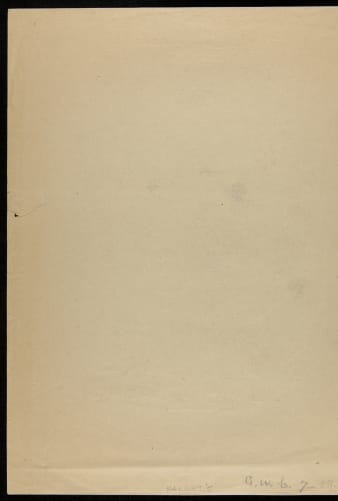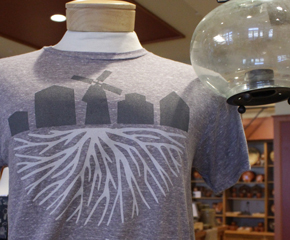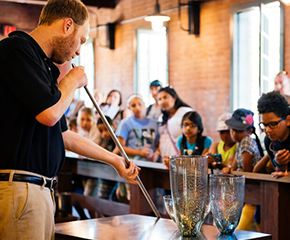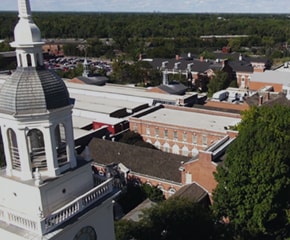
Irving R. Bacon Papers
Irving R. Bacon worked for Henry Ford as an artist. His work ranged from cartoons in the Ford Times to paintings of artifacts and events at the Edison Institute. His papers include photographs, drawings, and correspondence related to his career with Ford Motor Company and the Edison Institute.
Biographical / Historical Note
Born in 1875 in Fitchburg, Massachusetts, Irving Bacon received his early art training from Joseph Gies at the Art School of the Detroit Museum of Art. Much of his early work concentrated on illustrations and cartoons, and often his artwork reflected...
MoreBorn in 1875 in Fitchburg, Massachusetts, Irving Bacon received his early art training from Joseph Gies at the Art School of the Detroit Museum of Art. Much of his early work concentrated on illustrations and cartoons, and often his artwork reflected the influence of his travels to the American West. From 1894 to 1900 he worked as an illustrator at the Detroit Evening News and the Detroit Free Press. He first met Henry Ford through a mutual acquaintance in 1898, when he rode to Royal Oak and back to Detroit on Woodward Avenue in Henry's new automobile. In 1902 he went to New York City to study at the Chase School of Art and to illustrate for Harper's Weekly and McClure's. In 1906 he went to the Royal Academy in Munich and studied under Heinrich von Zugel, a noted animal painter. It was there where Bacon acquired his talent for painting landscapes and portraits. After returning to Detroit in 1910, he once again met Henry Ford, who by this time was a millionaire. Henry became interested in art largely due to the interest and talent of his own son, Edsel. He purchased a landscape scene from Bacon-a painting, which, according to Bacon, was "certainly not a masterpiece." It was after this meeting that Bacon gained permission from Henry to utilize his large estate for landscape paintings.
In 1913 he received a generous gift of money from his friend Harold Wills (a Ford executive), and once again returned to Munich for further study. His stay was cut short, however, due to the start of World War I. Upon returning to Detroit, he realized the need for a steady salary in order to adequately support his wife and six children, so he met again with Henry Ford and soon became an employee of the Ford Motor Company, drawing cartoons for the Ford Times and later, illustrations for The Dearborn Independent. Henry loved Bacon's cartoons, an area of work which Bacon wanted to discontinue. According to Bacon, "That class of work seemed to conflict with my high aims of art. Little did I realize at the time that I was beginning a thirty three year stretch of work for Henry Ford and his great organization that eventually would wean me away from the art world."
Working for Henry at the Ford Motor Company, and later the Edison Institute, Bacon's tasks included painting scenes and portraits that were of great interest to Henry Ford and his Museum and Village. These included portraits of Ford's family and friends, Noah Webster, Luther Burbank, Mark Twain, Dr. George Washington Carver, Stephen Foster, John Burroughs, and others. He was also responsible for creating paintings of the artifacts located at the institute, and he also acted as stage designer for the Museum's theater. His interest in photography and motion pictures led him to become the head of the Photographic Department for several years. Bacon retired from the Edison Institute in 1948, and moved to Miami with his second wife. He died in 1962 at the age of 86.
LessScope and Content Note
This collection is mainly composed of photographs, drawings, and some correspondence related to Bacon's career with the Ford Motor Company and the Edison Institute. The series within this collection are accordingly arranged to the different aspects...
MoreThis collection is mainly composed of photographs, drawings, and some correspondence related to Bacon's career with the Ford Motor Company and the Edison Institute. The series within this collection are accordingly arranged to the different aspects involved with the work of Henry Bacon. There are five series in the collection, the Golden Jubilee painting, Irving Bacon personal materials, Greenfield Village and Henry Ford Museum, Henry Ford related work, and Dearborn Independent.
Series I, Golden Jubilee painting: This series is comprised of pamphlets, notes, lists, correspondence, and photographs related Bacon’s painting entitled "Celebration of the Golden Jubilee of the Invention of the Incandescent Electric Light" also known as the "The Dedication of the Edison Institute of Technology." The Golden Jubilee occurred on October 21, 1929. It is arranged by the sub-series Printed material (1929), Correspondence (1936-1937), and Photographs (dates unknown, but assumed to be between 1920-1938). The photographs, which are mainly portraits of the individuals who attended the events of October 21, 1929, were obtained by Bacon in the years 1936-1938, for the purpose of recreating the dinner scene, some seven to nine years previous. Over 400 individuals attended this dinner, ranging from Henry Ford's personal friends to contemporary world business and political leaders. The number of dinner guests eventually included in Bacon's painting numbered 266. The filing arrangement for the Photographs subseries was left in much the same way that Bacon had organized it, which was by seating arrangements. He categorized his filing system according to "Tables," "Arches," and "Individuals Standing" e.g., Table 1, Arch 1, etc.
Series II, Irving Bacon personal materials: In this series are various materials (1907-1957) which apparently were kept for the personal use and interest of Mr. Bacon. A large portion of this series, theater interests, contains materials on early theater and film actors/actresses. The majority of the materials within this series are photographs, unless otherwise noted.
Series III, Greenfield Village and Henry Ford Museum: This series is an assortment of photographs, mixed with notes and sketches related to subjects found at Greenfield Village and Henry Ford Museum. Bacon collected photographs of the various subjects in order to study them and eventually create a likeness within his own paintings.
Series IV, Henry Ford related work: This series is an example of yet another type of work that Bacon undertook as an employee of Henry Ford. It reflects the personal interests of Henry Ford. Included are miscellaneous printed materials, photographs, sketches, and maps (photographed). The folders have retained the original titles given by Bacon himself.
Series V, Dearborn Independent: Irving Bacon's artwork created for the Dearborn Independent is found within this series (approximately 1925-1935). These oversized materials consist mainly of sketches, prints, and color drawings.
LessCollection Details
Object ID: 84.1.1657.0
Creator: Bacon, Irving R. (Irving Ruben), 1875-1962
Inclusive Dates: 1863-1957
Size: 4.4 cubic ft. and 4 oversize boxes
7.8 cubic ft. (17 boxes) [Collection Survey]
Language: English
Collection Access & Use
Item Location: Not Currently On Exhibit
Access Restrictions: The collection is open for research
Credit: From the Collections of The Henry Ford.
Digitized Artifacts From This Collection
In many cases, not all artifacts have been digitized.
Contact us for more information about this collection.
Portrait of Horace Mann
Artifact
Print (Visual work)
Date Made
1900
Summary
Horace Mann (1796-1859) was an influential education reformer from Massachusetts from the 1830s to the 1850s. He advocated for free, universal public education (supported by the state) and professional teacher training. Mann believed these and other ground-breaking reforms offered all students the same body of knowledge and an equal opportunity in life, as well as instilling a greater feeling of unity among American citizens.
Object ID
84.1.1657.14
Credit
From the Collections of The Henry Ford.
Location
By Request in the Benson Ford Research Center
Get more details in Digital Collections at:
Portrait of Horace Mann
What is The Henry Ford?
The national attraction for discovering your ingenuity while exploring America’s spirit of innovation. There is always much to see and do at The Henry Ford.
Portrait of Horace Mann
Artifact
Photographic print
Date Made
17 December 1934
Summary
Horace Mann (1796-1859) was an influential education reformer from Massachusetts from the 1830s to the 1850s. He advocated for free, universal public education (supported by the state) and professional teacher training. Mann believed these and other ground-breaking reforms offered all students the same body of knowledge and an equal opportunity in life, as well as instilling a greater feeling of unity among American citizens.
Place of Creation
Keywords
Object ID
84.1.1657.P.188.11600
Credit
From the Collections of The Henry Ford.
Location
By Request in the Benson Ford Research Center
Get more details in Digital Collections at:
Portrait of Horace Mann
What is The Henry Ford?
The national attraction for discovering your ingenuity while exploring America’s spirit of innovation. There is always much to see and do at The Henry Ford.





Correspondence between E.G. Liebold and P.E. Martin regarding Light's Golden Jubilee Banquet Painting
 Details
Details
Correspondence between E.G. Liebold and P.E. Martin regarding Light's Golden Jubilee Banquet Painting
Artifact
Correspondence
Date Made
02 July 1936-19 October 1936
Summary
In the mid-1930s, more than six years after the Light's Golden Jubilee celebration, Henry Ford commissioned a panoramic painting of that evening's banquet. Letters were sent to attendees asking them to indicate on an enclosed diagram where they sat and for a photograph so that their image could be included in the painting. P.E. Martin tried to remember his exact location, but only gave an approximation.
Keywords
Martin, P. E. (Peter Edmund), 1882-1944
Liebold, Ernest G. (Ernest Gustav), 1884-1956
Object ID
84.1.1657.6
Credit
From the Collections of The Henry Ford.
Location
By Request in the Benson Ford Research Center
Related Objects
Get more details in Digital Collections at:
Correspondence between E.G. Liebold and P.E. Martin regarding Light's Golden Jubilee Banquet Painting
What is The Henry Ford?
The national attraction for discovering your ingenuity while exploring America’s spirit of innovation. There is always much to see and do at The Henry Ford.










Correspondence between E.G. Liebold and Edwin W. Hammer regarding Light's Golden Jubilee Banquet Painting, 1936
 Details
Details
Correspondence between E.G. Liebold and Edwin W. Hammer regarding Light's Golden Jubilee Banquet Painting, 1936
Artifact
Correspondence
Date Made
02 July 1936 - 11 August 1936
Summary
In the mid-1930s, more than six years after the Light's Golden Jubilee celebration, Henry Ford commissioned a panoramic painting of that evening's banquet. Letters were sent to attendees asking them to indicate on an enclosed diagram where they sat and for a photograph so that their image could be included in the painting. Edwin Hammer sent a photograph and a transcription of his diary entry for that day.
Keywords
United States, Michigan, Dearborn
Bacon, Irving R. (Irving Ruben), 1875-1962
Edison, Thomas A. (Thomas Alva), 1847-1931
Liebold, Ernest G. (Ernest Gustav), 1884-1956
Object ID
84.1.1657.8
Credit
From the Collections of The Henry Ford.
Location
By Request in the Benson Ford Research Center
Related Objects
Get more details in Digital Collections at:
Correspondence between E.G. Liebold and Edwin W. Hammer regarding Light's Golden Jubilee Banquet Painting, 1936
What is The Henry Ford?
The national attraction for discovering your ingenuity while exploring America’s spirit of innovation. There is always much to see and do at The Henry Ford.


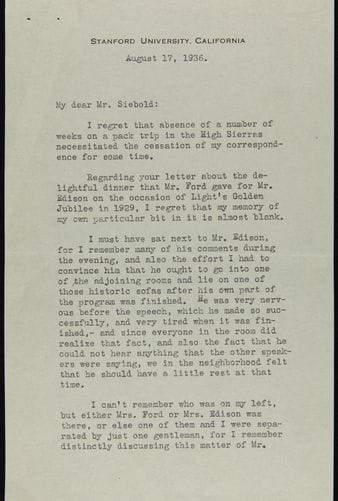







Correspondence between E.G. Liebold and Lou Henry Hoover regarding Light's Golden Jubilee Banquet Painting, 1936
 Details
Details
Correspondence between E.G. Liebold and Lou Henry Hoover regarding Light's Golden Jubilee Banquet Painting, 1936
Artifact
Correspondence
Date Made
03 July 1936 - 07 October 1936
Summary
In the mid-1930s, more than six years after the Light's Golden Jubilee celebration, Henry Ford commissioned a panoramic painting of that evening's banquet. Letters were sent to attendees--including those at the head table--asking where they sat and for a photograph so that their image could be included in the painting. Former First Lady Lou Henry Hoover replied and gave her impressions of the evening.
Keywords
United States, Michigan, Dearborn
Bacon, Irving R. (Irving Ruben), 1875-1962
Edison, Thomas A. (Thomas Alva), 1847-1931
Liebold, Ernest G. (Ernest Gustav), 1884-1956
Object ID
84.1.1657.10
Credit
From the Collections of The Henry Ford.
Location
By Request in the Benson Ford Research Center
Related Objects
Get more details in Digital Collections at:
Correspondence between E.G. Liebold and Lou Henry Hoover regarding Light's Golden Jubilee Banquet Painting, 1936
What is The Henry Ford?
The national attraction for discovering your ingenuity while exploring America’s spirit of innovation. There is always much to see and do at The Henry Ford.










Correspondence between E.G. Liebold and A.W. Robertson regarding Light's Golden Jubilee Banquet Painting, 1936
 Details
Details
Correspondence between E.G. Liebold and A.W. Robertson regarding Light's Golden Jubilee Banquet Painting, 1936
Artifact
Correspondence
Date Made
02 July 1936 - 17 December 1937
Summary
In the mid-1930s, more than six years after the Light's Golden Jubilee celebration, Henry Ford commissioned a panoramic painting of that evening's banquet. Letters were sent to attendees asking them to indicate on an enclosed diagram where they sat. Mr. A.W. Roberson, chairman at Westinghouse, sat at the head table. After Robertson responded, artist Irving Bacon requested an "exact side view" image of Mr. Robertson.
Keywords
United States, Michigan, Dearborn
Bacon, Irving R. (Irving Ruben), 1875-1962
Edison, Thomas A. (Thomas Alva), 1847-1931
Liebold, Ernest G. (Ernest Gustav), 1884-1956
Robertson, Andrew W. (Andrew Wells), 1880-1965
Object ID
84.1.1657.13
Credit
From the Collections of The Henry Ford.
Location
By Request in the Benson Ford Research Center
Related Objects
Get more details in Digital Collections at:
Correspondence between E.G. Liebold and A.W. Robertson regarding Light's Golden Jubilee Banquet Painting, 1936
What is The Henry Ford?
The national attraction for discovering your ingenuity while exploring America’s spirit of innovation. There is always much to see and do at The Henry Ford.
Nature's Garden for Victory and Peace, March 1942
Artifact
Bulletin
Date Made
March 1942
Summary
George Washington Carver directed the agricultural Experiment Station at Tuskegee Institute in Alabama. As part of his work, Carver wrote agricultural bulletins. In this bulletin, his last, Carver expanded on the value of wild edibles, one of his favorite topics. He encouraged readers to rely on wild plants if the war caused produce shortages. Carver believed that nature had already provided everything we needed to live well.
Place of Creation
Keywords
Object ID
84.1.1657.1
Credit
From the Collections of The Henry Ford.
Location
By Request in the Benson Ford Research Center
Get more details in Digital Collections at:
Nature's Garden for Victory and Peace, March 1942
What is The Henry Ford?
The national attraction for discovering your ingenuity while exploring America’s spirit of innovation. There is always much to see and do at The Henry Ford.


Document Listing Possible Names for Ford Motor Company's Nutritional Laboratory, July 28, 1942
 Details
Details
Document Listing Possible Names for Ford Motor Company's Nutritional Laboratory, July 28, 1942
Artifact
Draft (Documents)
Date Made
July 1942
Summary
This handwritten document with list of possible names for Ford Motor Company's Nutritional Laboratory may have been written by George Washington Carver. The list may have been generated during a discussion between Carver and Irving Bacon, who was painting Carver's portrait. The laboratory was dedicated simply with Carver's name.
Place of Creation
Object ID
84.1.1657.3
Credit
From the Collections of The Henry Ford.
Location
By Request in the Benson Ford Research Center
Get more details in Digital Collections at:
Document Listing Possible Names for Ford Motor Company's Nutritional Laboratory, July 28, 1942
What is The Henry Ford?
The national attraction for discovering your ingenuity while exploring America’s spirit of innovation. There is always much to see and do at The Henry Ford.
Pencil Sketch by George Washington Carver, July 29, 1942
Artifact
Drawing (Visual work)
Date Made
29 July 1942
Summary
George Washington Carver visited Dearborn in 1942 when Henry Ford dedicated a laboratory in his honor. But Carver wanted to honor Ford as well, producing this sketch of a statue to Ford at the museum entrance. Though Carver's hands shook due to illness, he had a grand monument in mind. "Oh," he told painter Irving Bacon, "I can visualize the spread of spiritual wings at its base..."
Object ID
84.1.1657.5
Credit
From the Collections of The Henry Ford.
Location
By Request in the Benson Ford Research Center
Get more details in Digital Collections at:
Pencil Sketch by George Washington Carver, July 29, 1942
What is The Henry Ford?
The national attraction for discovering your ingenuity while exploring America’s spirit of innovation. There is always much to see and do at The Henry Ford.















